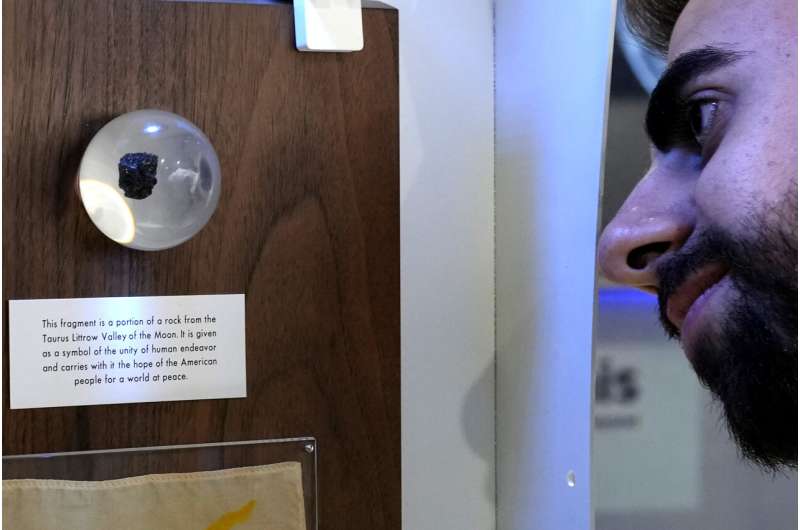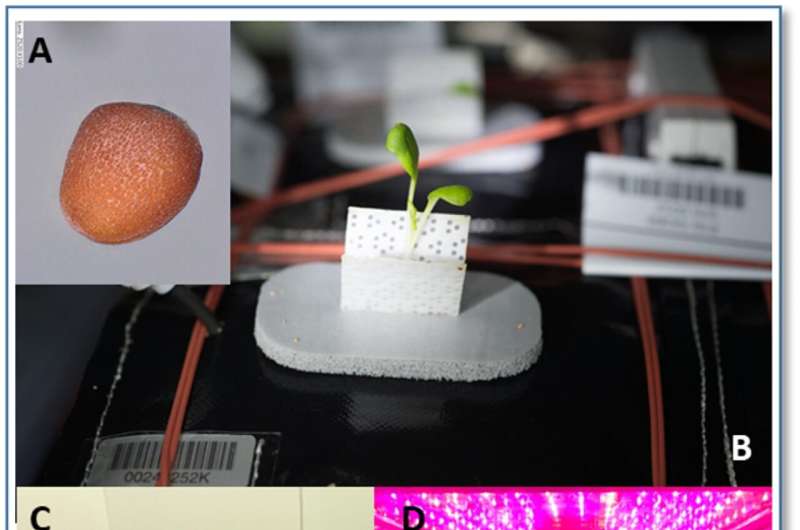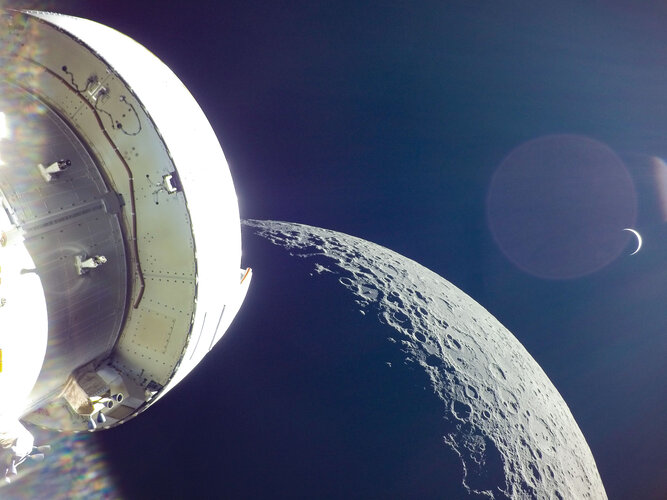
Copernical Team
Rare Apollo mission moon rock back in Cyprus after 50 years

Sowing the seeds of future space travel

After 908 days in low Earth orbit, a small package on board the X-37B Orbital Test Vehicle-6 has come home to the delight of some biological scientists. Soon they will open an aluminum alloy container that holds samples of plant seeds that they hope can be used to sustain astronauts on long duration missions to the moon, Mars, and beyond.
Officially, it is known as a SEER experiment, short for Space Environment Exposure Research, a pathfinder mission supported by NASA's Biological and Physical Sciences Division (BPS) in collaboration with the US Air Force.
Unofficially, they're referred to as the "Thrive in Space" experiments—a way to underscore the stepping-stone research that scientists are undertaking to help advance their fundamental understanding of what it takes to grow and protect plants beyond our planet.
Rising Earth
 Image:
Image:
NASA’s Orion spacecraft, powered by ESA’s European Service Module, shares a stunning new take on ‘Earth rise’ following the return powered flyby of the Moon.
This image was taken on 5 December, flight day 20, after the spacecraft completed a 3 minute 27 second burn to swing around the Moon and back to Earth.
Just before the burn, Orion made its second and final close approach to the Moon at 17:43 CET (16:43 GMT), passing 130 km above the lunar surface.
The burn, which used the European Service Module’s main engine, changed the velocity of the spacecraft by about 1054
Arctic Sweden in race for Europe's satellite launches
 As the mercury drops to minus 20 Celsius, a research rocket lifts off from one of the world's northernmost space centres, its burner aglow in the twilight of Sweden's snowy Arctic forests.
Hopes are high that rockets like this could carry satellites as early as next year, in what could be the first satellite launch from a spaceport in continental Europe.
At the launch pad, about an hour
As the mercury drops to minus 20 Celsius, a research rocket lifts off from one of the world's northernmost space centres, its burner aglow in the twilight of Sweden's snowy Arctic forests.
Hopes are high that rockets like this could carry satellites as early as next year, in what could be the first satellite launch from a spaceport in continental Europe.
At the launch pad, about an hour From Shetlands to Azores, Europe's space race takes off
 Projects to develop space centres that can launch satellites into Earth's orbit are sprouting up around Europe, amid the soaring popularity of small rockets and the commercialisation of space.
By the end of this year, Spanish start-up PLD Space expects to launch its Miura-1 mini-rocket from the El Arenosillo site in the southern region of Andalusia.
Satellites will also be launched "in t
Projects to develop space centres that can launch satellites into Earth's orbit are sprouting up around Europe, amid the soaring popularity of small rockets and the commercialisation of space.
By the end of this year, Spanish start-up PLD Space expects to launch its Miura-1 mini-rocket from the El Arenosillo site in the southern region of Andalusia.
Satellites will also be launched "in t The future market for small satellites
 The German federal government has launched the Small Satellite Initiative with the aim of consolidating the German space industry and supporting small and medium-sized enterprises (SMEs), especially start-ups, actively involved in the small satellite sector. The Bundestag allocated 10 million euros for this purpose in 2022. On 6 December 2022, representatives from industry, research and politics
The German federal government has launched the Small Satellite Initiative with the aim of consolidating the German space industry and supporting small and medium-sized enterprises (SMEs), especially start-ups, actively involved in the small satellite sector. The Bundestag allocated 10 million euros for this purpose in 2022. On 6 December 2022, representatives from industry, research and politics Absolut Sensing selects NanoAvionics to build demonstration satellite to be launched first half of 2024
 Absolut Sensing, a subsidiary of the Absolut Group specialized in the measurement of greenhouse gas emissions, has achieved a significant milestone with the selection of satellite manufacturer Kongsberg NanoAvionics (NanoAvionics) to build its demonstration satellite dubbed "GEN1", after a rigorous selection process. Under the mission agreement, NanoAvionics will provide its 16U nanosatellite bu
Absolut Sensing, a subsidiary of the Absolut Group specialized in the measurement of greenhouse gas emissions, has achieved a significant milestone with the selection of satellite manufacturer Kongsberg NanoAvionics (NanoAvionics) to build its demonstration satellite dubbed "GEN1", after a rigorous selection process. Under the mission agreement, NanoAvionics will provide its 16U nanosatellite bu Orbital Assembly announces new equity offering to Advance Hybrid-Gravity Space Station development
 Orbital Assembly (OA), a leader in the race to make Hybrid-GravityTM space accessible for leisure, commercial and industrial activities has announced a crowdfunding equity offering (Regulation CF).
The company continues to seek investment to initiate full scale human factors design in conjunction with NASA Marshall Space Flight Center, to begin construction of the first orbital flight hard
Orbital Assembly (OA), a leader in the race to make Hybrid-GravityTM space accessible for leisure, commercial and industrial activities has announced a crowdfunding equity offering (Regulation CF).
The company continues to seek investment to initiate full scale human factors design in conjunction with NASA Marshall Space Flight Center, to begin construction of the first orbital flight hard Slingshot Aerospace raises $40M in oversubscribed Series A2 funding round
 Slingshot Aerospace, Inc., a company building data and analytics products to make space operations safer, has announced that it has raised $40.85 million in an oversubscribed Series A2 funding round.
The round was led by Sway Ventures and included participation from others, including C16 Ventures, ATX Venture Partners, Lockheed Martin Ventures, Valor Equity Partners, and Draper Associates,
Slingshot Aerospace, Inc., a company building data and analytics products to make space operations safer, has announced that it has raised $40.85 million in an oversubscribed Series A2 funding round.
The round was led by Sway Ventures and included participation from others, including C16 Ventures, ATX Venture Partners, Lockheed Martin Ventures, Valor Equity Partners, and Draper Associates, Spirent brings realistic testing to emerging LEO satellite applications
 Spirent Communications plc (LSE:SPT), the leading provider of test and assurance solutions for next-generation devices and networks, has announced availability of SimORBIT, the first high-accuracy orbital modelling software solution specifically developed for Low Earth Orbit (LEO) satellite simulation.
Created in partnership with spaceborne receiver developer SpacePNT, Spirent SimORBIT ena
Spirent Communications plc (LSE:SPT), the leading provider of test and assurance solutions for next-generation devices and networks, has announced availability of SimORBIT, the first high-accuracy orbital modelling software solution specifically developed for Low Earth Orbit (LEO) satellite simulation.
Created in partnership with spaceborne receiver developer SpacePNT, Spirent SimORBIT ena 
